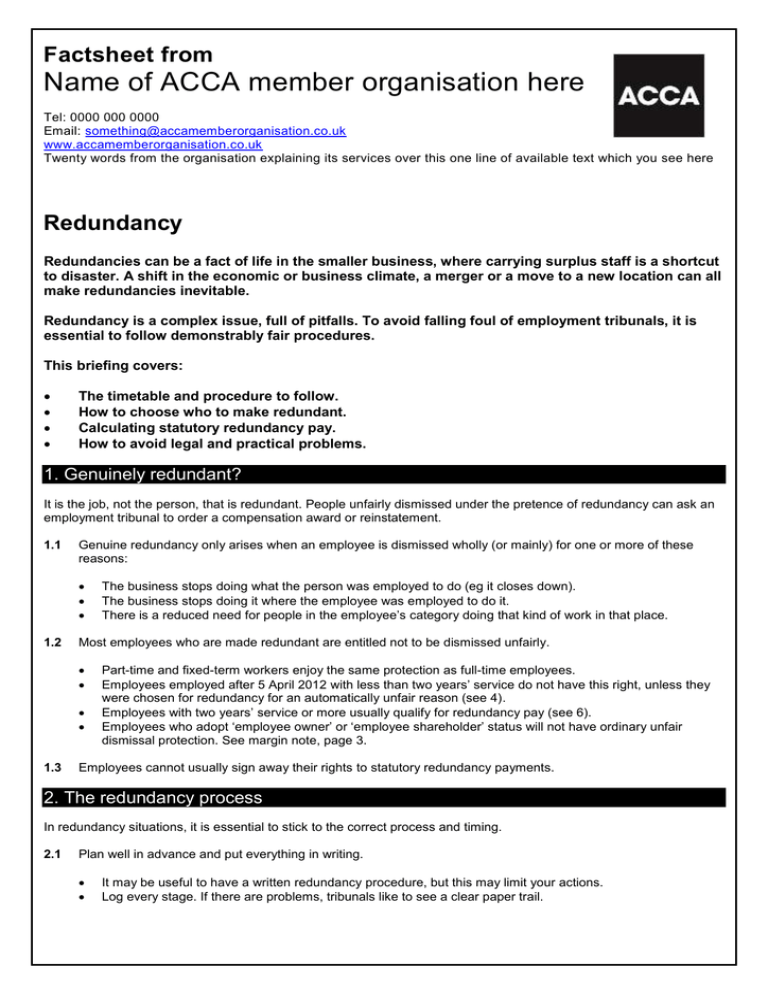
Factsheet from
Name of ACCA member organisation here
Tel: 0000 000 0000
Email: something@accamemberorganisation.co.uk
www.accamemberorganisation.co.uk
Twenty words from the organisation explaining its services over this one line of available text which you see here
Redundancy
Redundancies can be a fact of life in the smaller business, where carrying surplus staff is a shortcut
to disaster. A shift in the economic or business climate, a merger or a move to a new location can all
make redundancies inevitable.
Redundancy is a complex issue, full of pitfalls. To avoid falling foul of employment tribunals, it is
essential to follow demonstrably fair procedures.
This briefing covers:
The timetable and procedure to follow.
How to choose who to make redundant.
Calculating statutory redundancy pay.
How to avoid legal and practical problems.
1. Genuinely redundant?
It is the job, not the person, that is redundant. People unfairly dismissed under the pretence of redundancy can ask an
employment tribunal to order a compensation award or reinstatement.
1.1
Genuine redundancy only arises when an employee is dismissed wholly (or mainly) for one or more of these
reasons:
1.2
Most employees who are made redundant are entitled not to be dismissed unfairly.
1.3
The business stops doing what the person was employed to do (eg it closes down).
The business stops doing it where the employee was employed to do it.
There is a reduced need for people in the employee’s category doing that kind of work in that place.
Part-time and fixed-term workers enjoy the same protection as full-time employees.
Employees employed after 5 April 2012 with less than two years’ service do not have this right, unless they
were chosen for redundancy for an automatically unfair reason (see 4).
Employees with two years’ service or more usually qualify for redundancy pay (see 6).
Employees who adopt ‘employee owner’ or ‘employee shareholder’ status will not have ordinary unfair
dismissal protection. See margin note, page 3.
Employees cannot usually sign away their rights to statutory redundancy payments.
2. The redundancy process
In redundancy situations, it is essential to stick to the correct process and timing.
2.1
Plan well in advance and put everything in writing.
It may be useful to have a written redundancy procedure, but this may limit your actions.
Log every stage. If there are problems, tribunals like to see a clear paper trail.
2.2
Consult and notify in time.
There is no statutory fixed consultation period if less than 20 employees are involved. However, your
employment contracts may specify a consultation period.
For 20 or more people, you must begin consultations with employees or their representatives (see 3.2) and
notify the Redundancy Payments Service at least 30 days before the dismissals take effect.
If there are more than 100 people involved, you must begin consultations at least 45 days before the
dismissals take effect.
Failure to consult properly is potentially costly, as any individual can then ask a tribunal for a ‘protective
award’, giving up to 90 days’ full pay to every employee involved.
You must also be able to show that you have consulted each employee individually.
The first meeting is usually to describe the process and timescales, discuss possible alternative work and
explain redundancy pay calculations. Further meetings may be needed to give feedback and ultimately to
give notice and explain the appeals procedure.
2.3
Define the pool from which employees will be chosen for redundancy, decide what criteria you want to use and
select fairly from the pool (see 4).
Selection criteria, but not individual scorings, should be disclosed to employees as part of the consultation.
2.4
Give redundant employees notice, in line with the terms of their contracts (and at least the statutory minimum
notice period).
2.5
Implement the dismissals.
3. Avoiding redundancies
3.1
You are legally obliged to take reasonable steps to avoid compulsory redundancies.
3.2
The possibilities include short-time working, overtime bans, shedding temporary or contract labour, lay-offs,
transfers, redeployments, early retirements, or calls for volunteers. These should usually all be considered
and rejected as impractical before there are any compulsory redundancies.
Over time, natural wastage or a freeze on recruitment might achieve the same result.
If your plans involve 20 or more redundancies, you must consult with employees’ representatives or trade union.
Employee representatives can be existing representatives, information and consultation representatives or
new ones specially elected for the purpose.
The process must include consultation on how to avoid dismissals, how to reduce the numbers dismissed
and how to minimise the consequences.
Discussions must be genuine. There is a legal duty on the employer to consult ‘with a view to reaching
agreement’.
4. Choosing the people
You have wide scope to choose whatever selection criteria suits your business needs. Your choice will not be
challenged by an employment tribunal unless it is unreasonable or discriminatory. But you must be able to show the
criteria were applied fairly and consistently.
4.1
One common, traditional approach is LIFO (last in, first out).
If no other criteria are published, LIFO will usually apply.
4.2
Selection could be based on skill levels, experience or attendance records.
4.3
Selection could be based on performance, but only if objective measures exist (perhaps through an existing
appraisal system).
2
4.4
Selection must not be based on any discriminatory basis (eg gender, age or race).
4.5
Proceed with caution is you are considering making someone who is pregnant or on maternity leave
redundant. You must be able to prove the redundancy is not connected to the pregnancy or birth as that
would be ‘automatically unfair’. Involve the woman in the consultations. You have a legal obligation to offer
any available alternative work to those on maternity leave.
It is illegal to single a person out for redundancy because of participation in activities as an employee
representative. These activities might include:
Acting as an information and consultation representative.
Acting as a safety representative or safety committee member.
Acting as a trustee of a pension scheme.
Acting as a union representative (or as an employee-elected representative in redundancy
consultations).
No one can be penalised for trying to assert any of their statutory employment rights.
5. Voluntary redundancy
Voluntary redundancy programmes can only be launched in genuine redundancy situations.
5.1
Set out the terms of the package.
5.2
Specify who can apply for voluntary redundancy payments. For example, people at a certain level.
5.3
State that you may be unable to accept all volunteers for redundancy.
5.4
Consider offering early retirement, if your pension scheme allows it.
This is usually more acceptable to the workforce than compulsory redundancies.
Unlike enhanced lump-sum payoffs, it can create costly long-term commitments.
6. Statutory payments
Statutory redundancy payments are calculated according to the number of years service, and the employee’s weekly
earnings.
6.1
There will be an entitlement to statutory redundancy payments for everyone dismissed because of the situation,
except:
6.2
Service is counted up to a maximum of 20 years, with up to 1.5 weeks’ pay for each year of service.
6.3
People with less than two years’ service.
People who unreasonably refuse an offer of suitable alternative employment.
Employees who have adopted ‘employee owner’ or ‘employee shareholder’ status. See margin note, page 3.
Each year from age 41 onwards entitles a redundant person to 1.5 weeks’ pay.
Service between ages 22 and 41 counts for one week a year.
Service between ages 17 and 22 counts for half a week a year.
A ‘week’s pay’ is based on actual income (or average weekly earnings), but is capped at £464 a week.
Maximum statutory redundancy pay is therefore 20 x 1.5 x £450 = £13,920.
7. Normal payment practice
3
In practice, some employers pay more — sometimes a lot more — than the minimum.
7.1
You may pay more for several reasons.
To encourage people to volunteer for redundancy.
Out of goodwill, to maintain good relations with ex-employees, or to keep up the morale of employees who
remain.
Because of provisions written into your employees’ contracts, or because of custom and practice in your
industry.
If you always pay more than the minimum, this can become established as an implied right for your
employees.
7.2
Redundancy pay of up to £30,000 is usually free of tax.
Check your redundancy payment plans in advance with HM Revenue & Customs.
8. Employees’ rights
Employees under notice of redundancy have rights, apart from any redundancy payments.
8.1
The right to be offered ‘suitable alternative employment’, if possible.
This can be offered by the existing employer or by an associated employer.
If an offer is unreasonably refused, the employee loses the right to redundancy pay (eg if the differences
between the new job and the old job are insignificant).
It is wholly up to the employer to prove that alternative employment is suitable and refusal is unreasonable.
‘Reasonable’ refusal might be based on a major change in working hours, a cut in pay or the need to travel
or move house.
8.2
An employee can try out the new job for four weeks — or longer, by agreement. If it proves unsuitable,
he or she may leave and still get full statutory redundancy pay.
The right to reasonable time off during the notice period for job-hunting or to arrange training (on full pay).
This usually means two days in total.
9. Keeping up morale
9.1
Demonstrate that you are handling all redundancies fairly and with sensitivity.
Making generous provision to soften the blow (eg outplacement support) may defuse tensions.
9.2
Take action on internal morale among employees who remain.
9.3
Take action to counter negative publicity.
9.4
Tell suppliers and customers at the same time as you tell the workforce. Explain the reasons and the longterm benefits.
People under notice of redundancy are hard to manage and the quality of the work they produce may drop.
Consider inviting non-essential people or those who may cause unrest to leave before their notice is up, with
pay in lieu. Legal problems may arise if you let them go before the consultation period is over.
People under notice should not be made responsible for key customers, essential machinery or confidential
databases.
4
What goes wrong?
If you mishandle redundancies, you can easily find yourself facing unfair dismissal claims that will be hard to defend.
A.
The most common mistakes are:
B.
Employment tribunals can make compensatory awards in unfair dismissal cases of up to £76,574.
C
Not following the right procedures or departing from the correct timetable.
Using unfair redundancy selection criteria or methods.
Failing to consult properly with the individuals involved.
Awards do not include compensation for injured feelings, but are based on a simple calculation of the
employee’s present and future loss.
A tribunal can order you to reinstate or re-engage a redundant employee who has not been treated correctly,
although this is rare.
Takeovers and TUPE
The chance to ‘take costs out of the business’ may be one of the major motives for a takeover. In this case,
redundancies may be part of the logic of the move. But they must be genuine (see 1) and appropriate selection criteria
must be applied (see 4), possibly involving the new owner’s existing employees.
A.
If you take over the running of a business, you usually have the same responsibilities to employees as the
previous owner. Under TUPE — the Transfer of Undertakings (Protection of Employment) Regulations — all
contracts transfer to the new owner.
B.
An employee who started after 5 April 2012 with two or more years’ service (one year if they started before
this date) who is made redundant primarily because of the sale of the business will normally be regarded as
unfairly dismissed.
In theory, a new owner cannot pick and choose who to keep on. But the regulations note that an employer may
have acceptable reasons for trimming the workforce at the time of a takeover.
You are permitted to declare people redundant if there are good commercial reasons for the decision.
This is known as the ‘ETO’ test — are there sound ‘economic, technical or organisational reasons entailing
changes in the workforce’? If you follow a fair procedure, dismissals for these reasons will not be unfair.
Employment law is complex and is changing rapidly. This briefing reflects our understanding of the basic legal position
as known at the last update. Obtain legal advice on your own specific circumstances and check whether any relevant
rules have changed.
Note
Employees adopting ‘employee-owner’ or ‘employee-shareholder’ status under The Growth and Infrastructure Act 2013
forego some of their employment rights in return for shares in the business. This includes giving up the right to
redundancy pay and the right to ordinary unfair dismissal protection after two years’ continuous employment.
Last reviewed 01.04.14
© Atom Content Marketing 2014. ISSN 1369-1996. All rights reserved. No part of this publication may be reproduced or transmitted without the
written permission of the publisher. This publication is for general guidance only. The publisher, expert contributors and distributor disclaim all liability
for any errors or omissions. Consult your local business support organisation or your professional adviser for help and advice.
5





